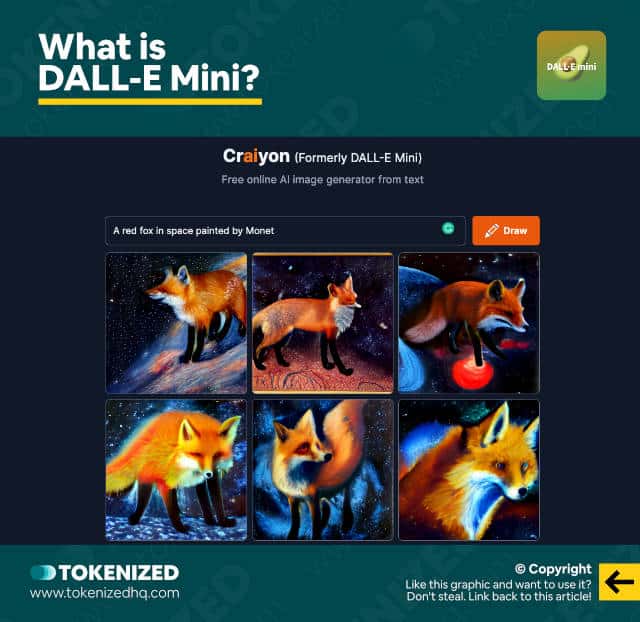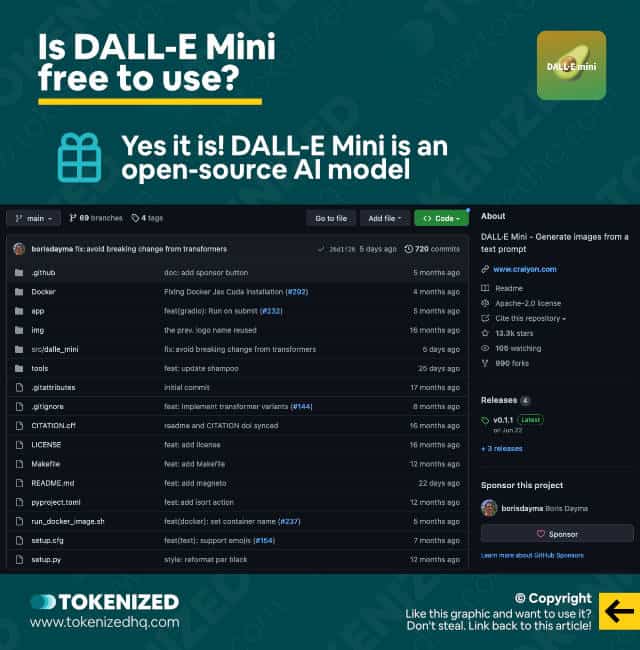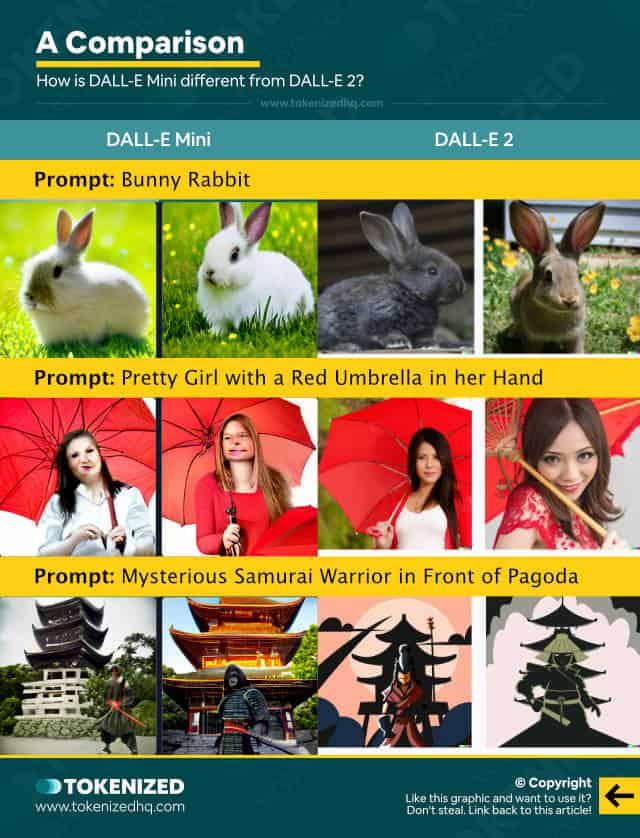Are you trying to learn more about DALL-E Mini?
Unless you’ve been living under a rock for the past year, you’ve most likely come across one story or another that deals with the crazy advancements in AI-generated art.
The most prominent examples of such AI generators are Midjourney and DALL-E, but in all likelihood, you’ve also bumped into another alternative, called DALL-E Mini.
In this guide, you’ll learn everything you need to know about DALL-E Mini and why it actually has little connection to OpenAI’s original DALL-E model.
Let’s dive right in.
Table of Contents Show
Like this content? Then share it!
DALL-E Mini: Everything You Need to Know
www.tokenizedhq.com
Here’s the answer. Great article by @ChrisHeidorn right here: https://tokenizedhq.com/dall-e-mini/
What is DALL-E Mini?

DALL-E Mini is a machine learning model, commonly referred to as AI, that generates images based on text-based user inputs called “prompts”.
It was created by a team of developers, led by Boris Dayma, as part of a community week organized by Hugging Face and Google Cloud.
The objective of the experiment was to reproduce the capabilities of OpenAI’s DALL-E with a much smaller system architecture that wasn’t as resource-consuming.
Within a span of fewer than 30 days, the team managed to collect 3 different datasets and used about 15 million images to train their AI model.
The initial demo was surprisingly impressive and the subsequent release of the free online generator spread like wildfire once people started sharing it across the internet.
It was particularly successful at the time because OpenAI’s new DALL-E 2 was still in a closed beta phase and most of the accessible alternatives were not for free.
Due to potential trademark conflicts, the DALL-E Mini website has since rebranded to “Craiyon“, however, the underlying AI models still carry the same name.
Key Points (tl;dr)
- DALL-E Mini started off as an experiment, trying to reproduce similar results as DALL-E but with a much smaller architecture.
- The AI model is open-source and is therefore free for anyone to use in their own projects.
- The online tool that is commonly shared among friends has since re-branded to “Craiyon”.
- Despite impressive results, it simply cannot compete with the most advanced AI models of OpenAI or Midjourney.
Is DALL-E Mini Free?

DALL-E Mini was and still is an open-source project and can be used and extended by anyone who wishes to do so.
While it isn’t as performant as most of the paid AI art generators, it’s an excellent starting point for anyone who wants to learn more about how to build their own AI-based products.
Here are some useful resources for developers who would like to take a closer look:
How is DALL-E Mini Different from DALL-E?

First of all, it’s important to state that there is no direct relation between the two, other than the name.
DALL-E and DALL-E 2 were developed by OpenAI, one of the leading software companies working on artificial intelligence, while DALL-E Mini started off as an open-source experiment.
The original DALL-E uses a 12 billion parameter version of GPT-3, which is roughly 27 bigger than what Boris Dayma and his colleagues used.
Furthermore, DALL-E was trained on 250 million pairs of images and text while DALL-E Mini only used about 15 million pairs.
Although the team used a very efficient approach to creating realistic AI-generated images, it is nowhere near as strong as DALL-E and it shows in the results.
Images created with DALL-E 2 are vastly superior and the number of resources being poured into its development is simply not comparable.
What Are the Limitations of DALL-E Mini?
During the original experiment, the development team was able to identify a number of limitations of the DALL-E Mini model.
These may get overlooked initially but the more time you spend looking at individual images, the more obvious they become.
Here’s a brief overview of these limitations:
- Humans and faces are generally not generated properly
- Animals are depicted in an unrealistic way
- Watermarks and other artifacts are often present
- The model does not perform well in languages other than English
- Societal biases are present throughout the model’s results due to the training data used
This underlines the common observation that software is only as intelligent and neutral as the data it was originally fed.
Frequently Asked Questions (FAQ)
Before we close off this guide, let’s quickly address some of the most common questions related to DALL-E Mini.
-
Are DALL-E and DALL-E Mini the same thing?
While the name is largely the same, DALL-E and DALL-E Mini are two different things. The original DALL-E was developed by OpenAI in 2021 and has since evolved into DALL-E 2, an even more advanced version of its AI image generator. DALL-E Mini was inspired by DALL-E, however, it started as an open-source experiment trying to reproduce similar results as DALL-E but with considerably less resource input.
-
Is DALL-E Mini free?
The DALL-E Mini AI model is open-source and therefore free to use. The web-based demo tool, which has since rebranded to “Craiyon”, is also free of charge.
-
Is Craiyon better than DALL-E Mini?
Craiyon is neither better nor worse than DALL-E Mini simply because it is one and the same. The Craiyon AI tool was formerly known as DALL-E Mini. We suspect that the name was changed to avoid trademark conflicts with OpenAI and open up potential pathways for commercial implementations of the open-source model.
Conclusion
So now that you have a better understanding of what DALL-E Mini is and how it differs from OpenAI’s DALL-E, it’s your duty to help clarify this whenever it comes up.
Remember, it all started off as an open-source experiment and it was never the objective to be as good as the original.
Using DALL-E Mini as a benchmark for what is currently possible with AI is also not a good idea, simply because the models used by OpenAI and Midjourney are considerably more advanced.
Here at Tokenized, we want to help you learn as much as possible about the AI software industry. We help you navigate the world of tech and the digitalization of our society at large, including the tokenization of assets and services.



